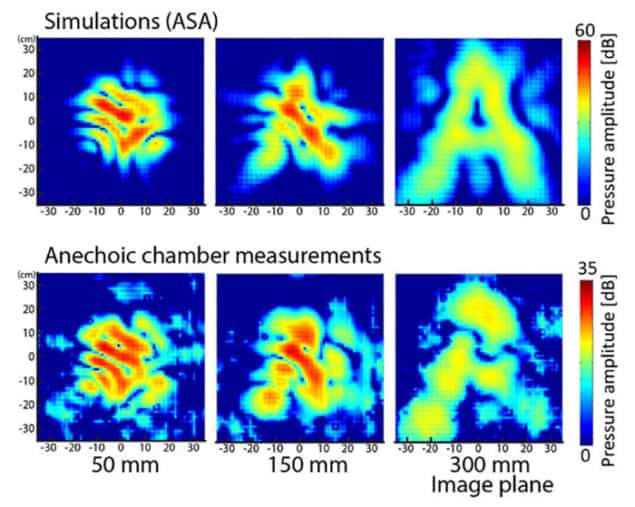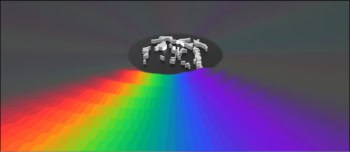
Researchers in the US have created a printed array of metamaterials that can produce passive 3D acoustic holograms from a simple sound source, such as a single speaker. The device is made up of 3D-printed Lego-like blocks that can be put together in different configurations. The researchers say that their method is cheaper and simpler than other techniques and that they expect it to “open a new realm of holographic acoustic wave manipulation”.
A visual hologram manipulates electromagnetic waves in the visible part of the spectrum to create a 3D image. Because sound also travels in waves, it should be possible to create complex 3D fields of sound – acoustic holograms – in a similar way. While visual holograms can be made with physical structures that diffract light, it isn’t so easy with sound due to a lack of materials with the required acoustic properties. Generally, acoustic holograms use a transducer array controlled by complex phase shifting electronics.
Shifting sound
The new device created by Steve Cummer, an electrical and computer engineer at Duke University in North Carolina, US, and colleagues uses metamaterials to create a physical structure that can shift sound waves into the required 3D shapes. Metamaterials are engineered materials that have structural properties that don’t usually occur naturally. They are used to control and manipulate light, sound and other physical phenomena.
The device is made up of a range of 12 3D-printed plastic blocks, or “cells”. Each cell contains a different labyrinth pattern that is designed to modulate the phase of an acoustic wave. They work at a frequency of 4000 Hz and the 12 cells cover 180° of relative phase delay. A double layer of the cells can produce 360° of relative phase delay.
Cummer told physicsworld.com that although printing the cells was “time consuming,” fabricating each individual piece was “straightforward”. The more challenging part, he added, “was actually designing the components so that each one manipulates sound in precisely the way we need”.
Wave patterns
The cells slot together and can be rearranged to create different wave patterns. Once built, the array is placed in front of a single speaker and the acoustic hologram is produced on the other side. The construction of the array was aided by numerical simulations that show how the cells individually affect sound waves and how they act in combination. The researchers tested two different holograms. First, they used the array to project sound in a letter “A” pattern 30 cm from the hologram. Then they rearranged it to produce three circular hot spots of sound of different diameters.
Cummer says that although the goal was to “simply demonstrate a new concept”, now they have established that it is possible they are “thinking hard about where the idea might be deployed”. One possible application is the creation of “an acoustic hologram that converts the sound from a single speaker into the much more complex sound field created by an orchestra”.
It could also potentially be used for medical imaging. The transducer arrays used in ultrasound devices allow the acoustic field to be adjusted during imaging. While the new technique does not offer this level of control, it could be used for simple imaging if “you knew the depth of the object you were trying to image”, Cummer says. Such devices would not be as capable as current ultrasound imaging systems, but they would be cheaper and “orders of magnitude less complex”.
Reconfigurable holograms
Bruce Drinkwater, professor of ultrasonics at the University of Bristol in the UK, says that “this is a really nice idea. Arrays are expensive, particularly the electronics required to drive them. This paper makes beam-forming much easier and cheaper.” Discussing its potential application for medical ultrasound, Drinkwater says that “[transducer] arrays are still the gold standard” but “if you want to perform a fixed beam-forming operation – e.g focus on a specific tumour on a specific patient – this idea is perfect.”
The device as tested does not work at ultrasound frequencies, but Cummer says that scaling it up or down to work at different frequencies “should be pretty straightforward”. “The challenge of scaling down for higher frequencies like ultrasound is simply manufacturing the components in a much smaller size. 3D manufacturing approaches are evolving very quickly, and we are working with colleagues with experience in this area to do exactly this.”
Cummer adds that they would also like to “be able to show the same kind of dynamic sound-field manipulation with a single source and reconfigurable hologram” as has been shown with transducer arrays. “We are working towards that.”
The work is published in Scientific Reports.



